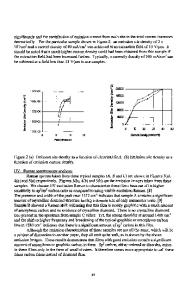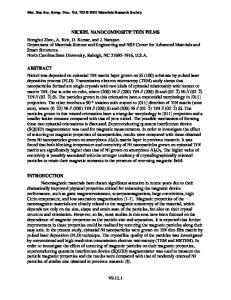IRS and ESR Characterizations of Nanocomposite Thin Films Derived From Alkanethiolates and Gold Nanoparticles
- PDF / 391,020 Bytes
- 6 Pages / 420.48 x 639 pts Page_size
- 29 Downloads / 290 Views
255 Mat. Res. Soc. Symp. Proc. Vol. 591 C 2000 Materials Research Society
quantization of electronic energy levels for fine metal particles leads to CESR, which is characterized by its g-value close to that of free electrons. This property was explored only for a limited number of nanoparticle systems, including palladium, silver and zinc [7-10]. A recent ESR study of zinc nanoparticles in solution has demonstrated that changes in lineshape, g-value and spin concentration could be correlated to particle isolation and agglomeration properties [10]. An assessment whether similar properties exist for thiolatecapped gold nanocrystal system is to our knowledge unexplored. EXPERIMENT Synthesis. The 2-nm Au nanoparticles (Au 2.nm) encapsulated with alkanethiolate shell were synthesized by the standard two-phase method [2]. Nanoparticles of the 5-nm core size (Au5.-m) were evolved from the Au2.,m particles by heating treatment [5]. Preparation. In a typical experiment [4], 1,9-nonanedithiols (NDT) were mixed in an organic solvent (hexane or toluene) with the decanethiolate (DT)-encapsulated nanoparticles in the concentration ranges of 0.1-10 piM nanoparticles and 0.5-5.0 mM dithiols. The film thickness was controlled by immersion time. The films were thoroughly rinsed with pure solvent before characterizations. Instrumentation. IRS spectra were acquired with a Nicolet 760 ESP FT-IR spectrometer that was purged with boil-off from liquid N 2, and equipped with a liquid N 2-cooled HgCdTe detector and an external specular reflectance device using p-polarized light at an incident of 820 with respect to surface normal. ESR data were collected using Bruker Model ESP 580, which was equipped with the capability of measurements at liquid-He temperatures. RESULTS AND DISCUSSION IRS Characterization. Figure 1 compares the IRS spectra with uncorrected spectral background for the thin films of the two particle sizes. 0.20-
b
0.0- •bFigure
0.00 1 4000
.
, . .. 3000 2000 Wuvenumbers(cm1
1. IRS spectra of thin films of the NDT-linked Au nanoparticles from 2-nm (a) and 5-nm (b) core sizes.
. 1000
)
The peak assignments for the C-H stretching bands are listed in Table 1, together with data from samples of the nanoparticles in KBr powder and thiolate monolayers on planar gold substrates. The clear reduction or absence of the methyl stretching bands (va(CH 3)~2956 and vs(CH 3)-2871 cml) relative to the methylene stretching bands ((va(CH 2)-2920 and v,(CH 2)-2850 cm-) is a strong piece of evidence supporting the replacement of the shell DT by NDT component. Interestingly, as shown in Table 1, the
256
methylene stretching bands for NDT in the nanocrystal network exhibited lower wavenumbers (5-10 cm'1) than those for NDT-derived monolayers on planar gold substrates. The magnitude of this reproducible shift also depended on particle size. This feature is indicative of a better packing or crystallinity of the alkyl chain structures in the nanocrystal thin films based on knowledge from planar substrate counterparts [I11 ]. In compariso
Data Loading...










